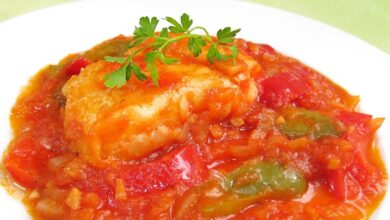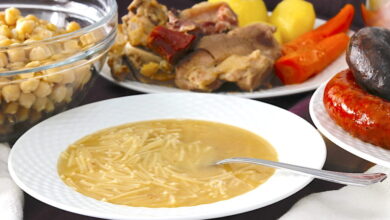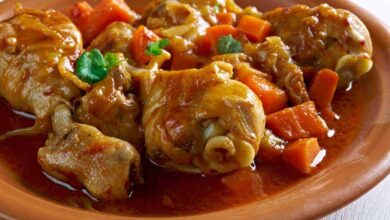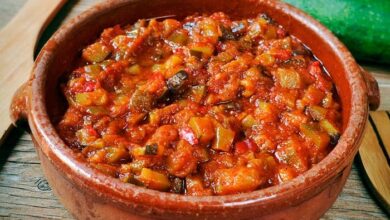Paella Valenciana recipe (Valencian Paella)
Today, in Spain from the Cuisine, we going to learn to elaborate one of the most famous Spanish recipe, the Paella Valenciana recipe or “Valencian Paella” in English.
The origin of Paella Valenciana, also known as Valencian paella, is rooted in the region of Valencia, Spain. It is a traditional rice dish that has been enjoyed for centuries and has become a staple of Spanish cuisine.
The dish is said to have originated in the mid-19th century, in the rural areas surrounding the city of Valencia. Farmers would cook rice and vegetables in a flat pan over an open flame, using whatever ingredients were available, such as rabbit, chicken, snails, and various vegetables. Over time, the dish evolved, and seafood, such as shrimp and mussels, was added to the recipe.
Paella Valenciana is typically made with a specific type of rice called Bomba, Calasparra or Arboreo rice, which is grown in the region and is known for its ability to absorb liquid without losing its texture. Other key ingredients include saffron, paprika, and green beans. The dish is cooked in a large, shallow pan called a paellera, which allows the rice to cook evenly and form a crispy crust on the bottom, known as socarrat.
Today, Paella Valenciana is a popular dish that is enjoyed throughout Spain and around the world. It is often served during festivals and special occasions and is a symbol of Spanish culture and tradition.
Ingredients of Paella Valenciana recipe
- 1 glass of extra virgin olive oil.
- 1 chopped chicken.
- 1 chopped rabbit.
- 300 grams of fresh Ferradura beans.
- 1 medium tomato.
- 1 tablespoon of sweet paprika.
- Saffron.
- 6 glasses of water.
- 200 grams of Garrofó beans.
- Salt to taste.
- 3 glasses of rice.
- 1 sprig of rosemary.
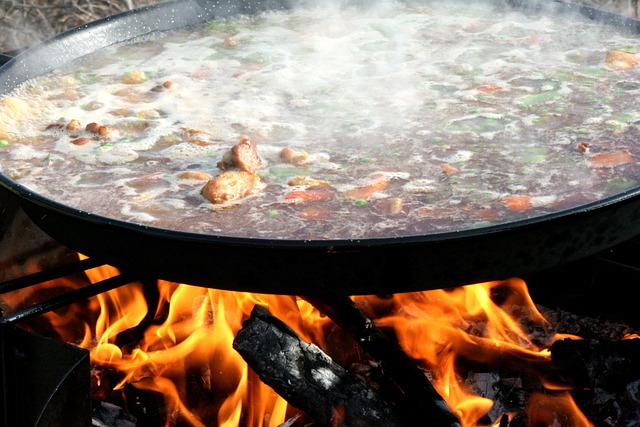
Ingredient substitutions for Valencian Paella recipe
Here are the notes and possible substitutions for the ingredients of Paella Valenciana:
- Extra virgin olive oil: You can use any other vegetable oil if needed.
- Chopped chicken: You can use any other type of poultry, such as turkey or duck, or even omit it for a vegetarian version.
- Chopped rabbit: You can substitute it with chicken, pork, or lamb, or again, omit it for a vegetarian version.
- Ferradura beans: You can substitute them with any other type of fresh or canned beans, such as lima beans or chickpeas.
- Medium tomato: You can use canned tomatoes if fresh ones are not available.
- Sweet paprika: You can use smoked paprika for a different flavor.
- Saffron: You can use turmeric or annatto as a coloring agent if needed.
- Water: You can use chicken or vegetable broth for a richer flavor.
- Garrofó beans: You can substitute them with any other type of fresh or canned beans, such as lima beans or chickpeas.
- Rice: You can use any short-grain rice, such as Arborio or Calasparra, but adjust the cooking time and liquid ratio accordingly.
- Rosemary: You can use any other type of fresh or dried herbs, such as thyme or oregano, for a different flavor.
Directions of Paella Valenciana recipe
Every paella worth its salt starts with a good sofrito. In a paella, the bigger the better, you fry chicken, rabbit, beans, artichokes, and snails in plenty of oil, seasoning with a little salt and paprika towards the end. Once it’s nicely browned, add the crushed tomato and sauté.
Once the sofrito is ready, water should be added. The proportions depend a lot on the fire, the heat, the degree of humidity, and the size of the paella, but to start off, a good proportion is to add three times the volume of water as rice, although experience will help you adjust and perfect these amounts, which you will end up doing by eye.
Now, increase the power and cook the broth well for 25-30 minutes. This is a good time to add saffron or, failing that, paella seasoning, which contains salt, garlic, coloring, and a bit of saffron.
Then, add the rice “in a diagonal pile” and spread it over the paella. Cook for between 17 and 20 minutes, although the time is determined again by the rice grain and the fire power, which we should let reduce. It should be completely dry and loose. My recommendation for first-timers is to have a pot of boiling water nearby in case more water needs to be added. Halfway through cooking, we can also add a few sprigs of rosemary, which we will remove before serving.
TIP: During the last minutes of cooking, increase the heat to medium-high to form a crispy crust (socarrat) on the bottom of the pan.
Finally, it’s advisable to let the paella rest for a few minutes covered with a large cloth, before serving and receiving the applause of those present.
Enjoy the Paella Valenciana !!
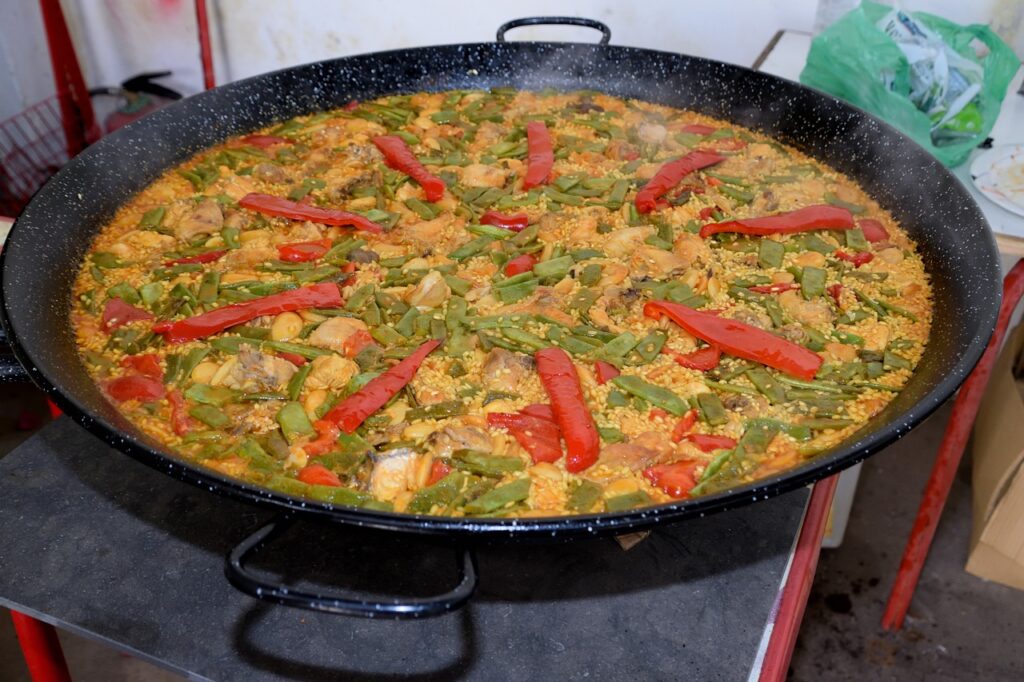
Tips for Paella Valenciana recipe
Here are some tips for making a great Paella Valenciana:
- Use a paella pan: Use a traditional paella pan, which is a wide and shallow pan with two handles, to ensure that the rice cooks evenly and forms a crispy crust (socarrat) at the bottom.
- Use the right rice: Use a short-grain rice, such as Bomba, Calasparra or Arborio, which can absorb more liquid and flavor without turning mushy.
- Brown the meat: Brown the chicken and rabbit in the pan with the olive oil to develop a deep flavor and caramelization.
- Use homemade broth: Use homemade chicken or vegetable broth for a richer flavor. Alternatively, you can use a combination of broth and water for a balanced taste.
- Don’t stir the rice: Once you add the rice to the pan, do not stir it too much. Instead, shake the pan gently to distribute the rice evenly and prevent it from sticking to the bottom.
- Add the saffron at the right time: Soak the saffron in a bit of hot water for a few minutes before adding it to the paella. Add it to the pan along with the tomato and let it infuse the rice with its flavor and color.
- Cook the rice over low heat: Cook the paella over low to medium heat to allow the rice to absorb the liquid gradually and form a crispy crust at the bottom.
- Let it rest: Once the paella is done, cover it with a clean kitchen towel and let it rest for a few minutes before serving. This will allow the flavors to meld together and the rice to settle.
Suggestions for serving
Here are some suggestions for serving Paella Valenciana:
- Serve hot: Paella Valenciana is best served hot, straight from the pan. Make sure to let it rest for a few minutes before serving to allow the rice to settle and the flavors to meld together.
- Serve with lemon wedges: Serve the paella with lemon wedges on the side. Squeezing a bit of lemon juice over the rice can help cut through the richness and add a bright flavor.
- Garnish with fresh herbs: Garnish the paella with fresh herbs, such as chopped parsley or cilantro, for a pop of color and freshness.
- Serve with a side salad: Paella Valenciana is a hearty dish, so serving it with a light side salad can help balance the flavors and textures.
- Pair with a Spanish wine: Pair the paella with a Spanish wine, such as Tempranillo or Garnacha, for a complete culinary experience.
- Enjoy with friends and family: Paella Valenciana is a communal dish that is best enjoyed with friends and family. Gather around the pan and share the experience together!
- Serve with aioli: Aioli, a garlicky mayonnaise-like sauce, is a classic accompaniment to paella in Spain. You can serve it on the side or drizzle it over the top of the rice for an extra burst of flavor.
- Use a wooden spoon: To serve the paella, use a wooden spoon to scoop the rice out of the pan. This will prevent scratching the surface of the pan and ensure that you get some of the crispy socarrat at the bottom of the pan.
- Enjoy the leftovers: Paella Valenciana reheats well and can make for a delicious lunch or dinner the next day. Store the leftovers in an airtight container in the refrigerator and reheat gently in the oven or on the stovetop.
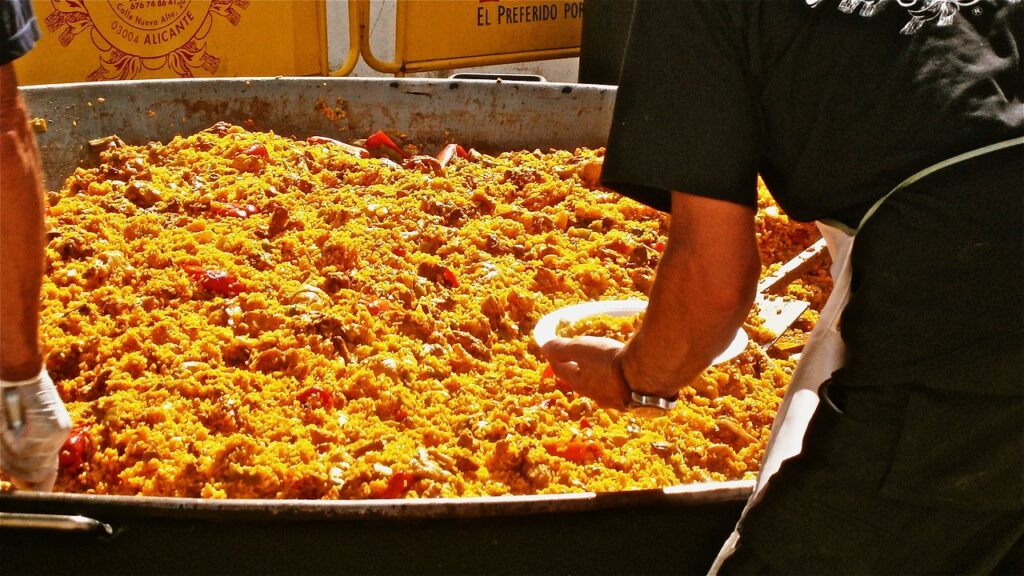
FAQs
Here are some possible FAQs that someone might ask about making Paella Valenciana:
- What is the best type of rice to use for Paella Valenciana? Short-grain rice, such as Bomba, Calasparra or Arborio, is the best type of rice to use for Paella Valenciana. These types of rice can absorb more liquid and flavor without turning mushy.
- Can I use a different type of meat instead of chicken and rabbit? Yes, you can use different types of meat in your paella.
- Do I need to soak the saffron before using it in the paella? Yes, it’s a good idea to soak the saffron in a bit of hot water for a few minutes before using it in the paella. This will help release its flavor and color.
- Can I make paella without a paella pan? While a paella pan is ideal for making paella, you can use a wide and shallow skillet as a substitute. Just make sure to use a pan that can hold all the ingredients without overcrowding.
- How do I know when the paella is done? The paella is done when the rice is cooked through and has absorbed all the liquid, and a crust (socarrat) has formed on the bottom of the pan. The cooking time can vary depending on the heat and the type of rice used.
- How should I store leftover paella? Store leftover paella in an airtight container in the refrigerator for up to 3-4 days. Reheat gently before serving.
- Can I make paella for a large crowd? Yes, paella can be made for a large crowd by using a larger paella pan or multiple pans. Just make sure to adjust the ingredient amounts accordingly and give yourself enough time to cook everything properly.


